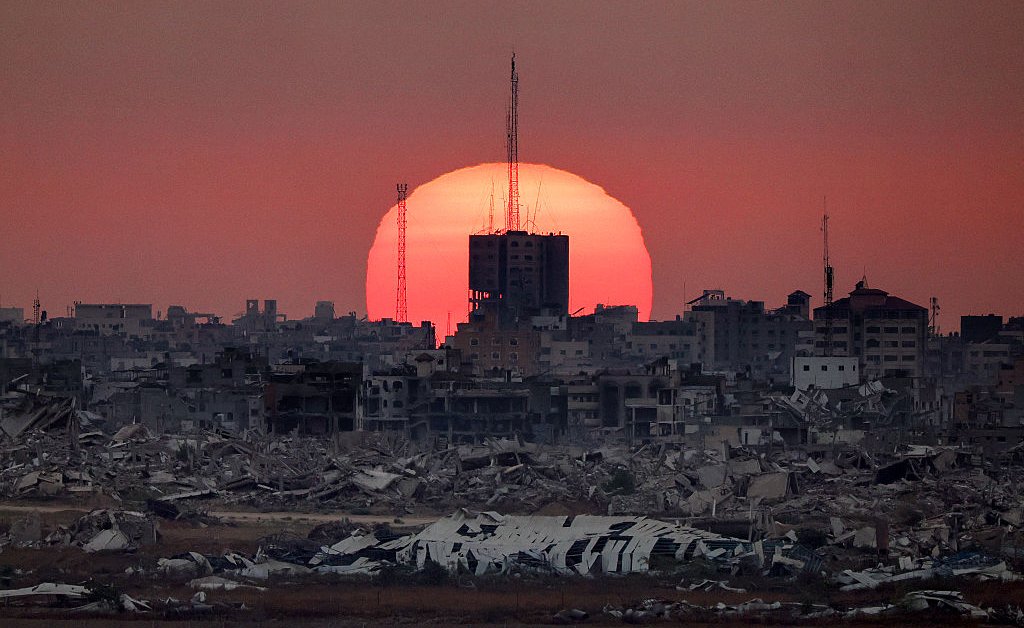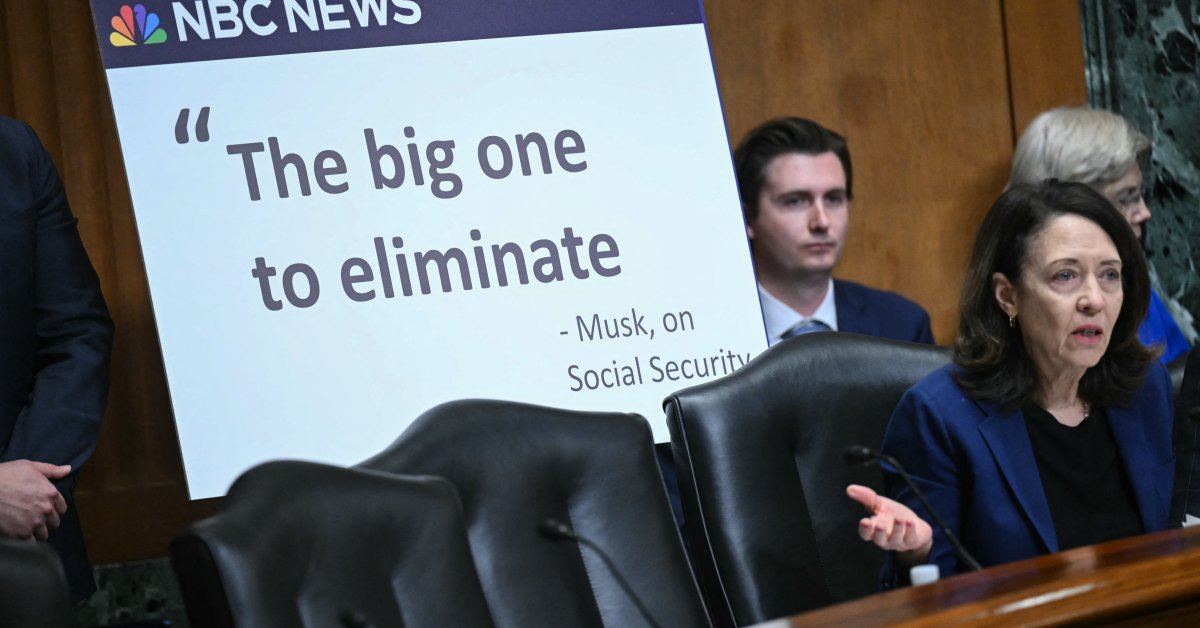Israel is open to accepting a 60-day ceasefire, President Donald Trump announced Tuesday, urging Hamas to sign the deal that he said would pave the way for a potential “end” to the war in Gaza.
Trump’s announcement comes as he expects a visit from Israeli Prime Minister Benjamin Netanyahu to the White House next week. Last week, the President upped the pressure on Israel and Hamas to reach an agreement that would end the war in Gaza and release the remaining Israeli hostages.
It’s also come a day after one of the deadliest days in Gaza, as Israeli attacks killed more than 70 people. More than 56,000 Palestinians and more than 1,700 Israelis have been killed over the course of the war that began when Hamas attacked Israel on Oct. 7, 2023.
Trump’s shift in focus towards Gaza follows the tenuous ceasefire brokered between Israel and Iran in June after the U.S. joined Israel in bombing Iranian nuclear facilities. Trump may be hoping that, with a weakened Iran—one of Hamas’ key allies in the region—Hamas may be pressured to accept the conditions of this ceasefire agreement.
“My Representatives had a long and productive meeting with the Israelis today on Gaza. Israel has agreed to the necessary conditions to finalize the 60 Day CEASEFIRE, during which time we will work with all parties to end the War,” Trump posted on Truth Social on Tuesday evening. “I hope, for the good of the Middle East, that Hamas takes this Deal, because it will not get better — IT WILL ONLY GET WORSE.”

Trump said that mediators Egypt and Qatar will deliver the final ceasefire proposal. The terms have not yet been publicly released, though reports say it would involve Hamas releasing 10 living Israeli hostages and 18 deceased ones during the 60-day ceasefire period. There are an estimated 50 hostages still in Gaza, of whom Israel believes around half are dead. The remaining hostages would be released upon the agreement of a permanent ceasefire.
Earlier Tuesday, Trump said Netanyahu “wants to” reach a ceasefire deal and teased that one would likely come next week. Israeli Minister for Strategic Affairs Ron Dermer met with Trump officials, including Middle East envoy Steve Witkoff, Tuesday, and a senior Israeli official told Axios that Dermer is prepared to begin indirect talks with Hamas concerning the deal.
Trump ranted over the weekend about corruption proceedings against Netanyahu in Israel, calling it “a Witch Hunt,” and Netanyahu’s hearings this week were postponed on the basis of classified diplomatic and security reasons.
Read More: Trump Tries to ‘Save’ Netanyahu as Israeli PM Faces Challenges at Home
Earlier ceasefires have faltered
Talks between Israel and Hamas have been stymied by disagreement over whether a ceasefire should include an end to the war. Hamas says a ceasefire must include the end of the war and a full withdrawal of Israel’s military from the Gaza Strip, which Israel has refused. Israel says it will only end its war in exchange for the dismantling and exile of Hamas, which Hamas has refused.
An offer had already been on the table. Hamas had reportedly offered to release all hostages in exchange for a full withdrawal of Israel’s military from Gaza and an end to the war. On Sunday, Hamas official Mahmoud Mardawi reportedly said Netanyahu insisted on a temporary agreement that releases only 10 hostages.
Mardawi accused Netanyahu of setting “impossible conditions aimed at thwarting the possibility of reaching a ceasefire agreement and a deal on the hostages.”

Previous ceasefire proposals have only been agreed to by one side or have proved short-lived.
In November 2023, six weeks after the outbreak of war, Israel and Hamas began an initial four-day ceasefire. Hamas returned 50 Israeli hostages in exchange for the release of 150 Palestinian women and children held in Israeli prisons. Israel said it would extend the truce for the release of 10 more captives per day, but Netanyahu said he did not want a permanent ceasefire until Israel achieved his aim of dismantling Hamas.
The ceasefire collapsed a week later in December 2023 after 110 hostages and 240 Palestinians were exchanged. Talks to extend the truce further failed as Israel refused Hamas’ demand for all of the roughly 10,000 Palestinian prisoners, including 400 children, to be freed, and as Hamas refused to release captive women soldiers as part of its agreement to release all women and children held in Gaza. Also that month, the U.S. vetoed a United Nations Security Council proposal to stop the war, claiming that Hamas refused to accept a two-state solution, although Hamas’ 2017 charter officially accepts one.
Hamas at the time was reviewing a three-stage ceasefire proposal by Arab, Israeli, and U.S. negotiators that involved the release of Israeli captives, opening up of aid, and return of dead Israeli hostages in exchange for Palestinian prisoners. Netanyahu ultimately rejected the proposal after Hamas asked for Israeli military withdrawal from Gaza, the release of at least 1,500 Palestinian prisoners, and a four-and-a-half-month ceasefire in exchange for releasing all Israeli hostages.
In March 2024, the UNSC passed a ceasefire proposal with 14 out of 15 members voting in favor. The U.S. abstained, after earlier in February vetoing another ceasefire resolution on the basis that it would impact talks between the U.S., Egypt, Israel, and Qatar. Later, the U.S. said the UNSC resolution was “non-binding.”
In May 2024, Hamas agreed to a three-stage ceasefire proposal from Egypt and Qatar that involved releasing all Israeli hostages in exchange for some number of Palestinian prisoners, increasing aid into Gaza, the gradual withdrawal of Israel from Gaza, and lifting Israel’s siege on Gaza since 2007. Israel, however, rejected the proposal, instead launching a new military offensive in the city of Rafah.

Then-President Joe Biden also laid out a three-phase proposal at the end of May 2024 that would include the release of Israeli hostages and a “full and complete ceasefire.” But shortly after Biden announced the proposal, Netanyahu said Israel would not end the war “until all of its goals are achieved,” including “the elimination of Hamas’ military and governmental capabilities.”
Netanyahu said in June that he would only accept a “partial” deal that returns Israeli hostages in return for pausing—but not ending—the war.
In August, Netanyahu reportedly supported the terms of a so-called “bridging” proposal meant to meet in the middle of both sides’ demands after talks in Doha negotiated by the U.S., Egypt, and Qatar. Hamas, however, rejected the plan, saying its terms, which were not officially made public, included conditions that it could not agree to, such as Israel’s refusal of a full ceasefire and military withdrawal from Gaza. Instead, Hamas called for Netanyahu to sign Biden’s earlier proposal.
On Jan. 19, 2025, Israel and Hamas began a three-phase ceasefire after delayed talks and Israeli military escalation. But after the first phase had been achieved, the ceasefire collapsed in March when Israel launched fresh airstrikes on Gaza before declaring that it was resuming the war.
Sticking points likely remain
It’s unclear whether Trump’s proposal, which Hamas has not yet agreed to, will take hold or prove more lasting than prior efforts. But domestic and international pressure has mounted on the U.S., Israel, and Hamas to bring the war in Gaza to an end as it drags into its 21st month.
Over the weekend, protesters in Israel called for a deal that would free the remaining hostages in Gaza. “There’s a deal on the table,” said Einav Zangauker, the mother of one of the hostages, at the rally. “What prevents it is Netanyahu’s refusal to end the war.”

Trump allies have suggested it is entirely on Hamas now. “Take the deal, or face the consequences,” former White House physician Rep. Ronny Jackson (R, Texas) posted on X. Whether those consequences could include U.S. involvement, as was the case with Iran, are unclear. Trump has on multiple occasions during his campaign and at the start of his second-term presidency vowed that the militant group will have “hell to pay” if it does not release all the hostages.
Hamas is generally positive about the proposal, but has conditions, Hamas sources told London-based news outlet Al-Sharq Al-Awsat. Those conditions include a demand to make it more difficult for Israel to resume the war if a permanent ceasefire is not achieved by the end of the 60 days such as through the gradual release of the 10 hostages, a source involved in the negotiations told the Times of Israel.
Still, while Trump has asserted that Israel is on board with a ceasefire proposal, observers suggest that may indicate the terms are unlikely to be acceptable to Hamas.
“If Netanyahu has agreed to another interim deal, it’s almost certainly with language that doesn’t commit him to end war,” Middle East analyst and former U.S. diplomat Aaron David Miller posted on X. “The main holdup today is exactly the same as it was last year: Israel’s unwillingness to permanently end the war and Hamas’s refusal to accept anything less,” added foreign policy analyst and writer Daniel DePetris. “Unless Trump has found a way to crack those two irreconcilable positions, this is all theater.”








